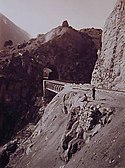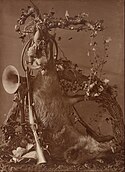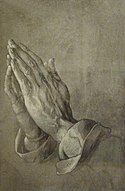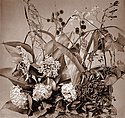Adolphe Braun
| Adolphe Braun | |
|---|---|
 | |
| Narození | 13. června 1812 Besançon |
| Úmrtí | 31. prosince 1877 (ve věku 65 let) Mylhúzy |
| Povolání | fotograf a kunsthistorik |
| Děti | Paul Gaston Braun |
| Některá data mohou pocházet z datové položky. | |


Adolphe Braun (13. května 1812 Besançon – 31. prosince 1877 Dornach) byl francouzský textilní designér a fotograf.
Život a dílo
Pracoval jako projektant a designér vzorů textilního materiálu v tiskárně kartounů v Mylhúzech (Alsasko). V roce 1847 se začal věnovat fotografii a v roce 1850 si otevřel v Dornachu (v roce 1913 byl začleněn k Mylhůzám) své vlastní studio a v roce 1868 také jedno v Paříži. Mezi jeho hlavní zájmy v období na počátku 60. let byla výroba topografických pohlednic Evropy. Později se vrátil k reprodukci uměleckých děl, jako byly obrazy, kresby, litografie, lepty nebo sochy. S reprodukcí slavných obrazů získal celosvětovou proslulost. K vytvoření potřebného velkého množství používal především metodu uhlotisku. V roce 1869 byl pozván, aby fotograficky zdokumentoval otevření Suezského průplavu v Egyptě. Další významnou oblastí, které se věnoval byla panoramatická krajinářská fotografie pořizovaná velkoformátovým fotoaparátem.
Byl průkopníkem módní fotografie. Roku 1856 vydal knihu, která obsahovala 288 fotografií Virginie Oldoiniové, hraběnky Castiglione, toskánské šlechtičny, milenky Napoleona III. Fotografie ji zobrazovaly v jejích dvorských šatech, které se považují za první fotografovaný módní model.[1]
Ve své době získal řadu ocenění a medailí na fotografických výstavách.
Během prusko-francouzské války dokumentoval mnoho škod a poškození, zejména na mostech. Později dokumentoval stavbu Gotthardské železnice a Gotthardského tunelu, které byly dokončeny a uvedeny do provozu v roce 1882.
Vlastnil mimo jiné také farmu s osmdesáti kravami a deseti koňmi.
Po jeho smrti v jeho práci a vedení společnosti pokračoval jeho syn Gaston Brown. Název podniku byl změněn v roce 1889 na „Braun, Clément et Cie“ a v roce 1910 na „Braun et Cie“.[2]
Fotografické cykly
- Fleurs photographiées (1854) – Série fotografií květin a kytic pro dekorativní umění. Cf: bibliographie Pierre Gascar.
- Les animaux de ferme (kolem 1860)
- Les vues panoramiques de la Suisse, de Paris, de Savoie, de l'Italie (1866–1870)
- La panoplie du gibier (1867)
- Les costumes de la Suisse (1869), Découvrir cette magnifique série
- Les vues d'Égypte réalisées à l'occasion de l'inauguration du Canal de Suez (1869)
- Le Théâtre de la guerre à Paris, Strasbourg et Belfort (1870-1871)
Výstavy
Galerie
Adolphe Braun: Pont des chemins de fer, Argenteuil, 1871
Adolphe Braun: Pont de Champigny-sur-Marne, 1871
Adolphe Braun: Asnières, Chemin de fer, 1871
Adolphe Braun: Gotthardbahn Luftlokomotive (výřez).[4]
Adolphe Braun: Gotthardbahn Tunneleingang in Airolo (výřez).[4]
Adolphe Braun: Gotthardbahn Untere Tessinbrücke mit Giornico (výřez).[4]
Adolphe Braun: Gotthardbahn Strahllochbrücke (výřez).[4]
Belfort, 1870-71
Saint-Cloud, 1871
Reprodukce sochy Saint Jean Baptiste od Augusta Rodina
Reprodukce obrazu Mains en prière Albrechta Dürera
Zátiší s loveckou scénou, 1867
Odkazy
Reference
- ↑ Solomon-Godeau, Abigail, "The Legs of the Countess." October 39 (Winter 1986): 65–108. Reprinted in Fetishism as Cultural Discourse, Emily Apter and William Pletz, eds. (Ithaca and London: Cornell University Press, 1993):266–306.
- ↑ Hannavy, John: Encyclopedia of nineteenth-century photography, vol 1, str. 205, Routledge, New York, London , 2008
- ↑ http://books.google.cz/books?id=PJ8DHBay4_EC&pg=PA514&lpg=PA514&dq=1855+Paris+Universal+Exposition+photographers&source=bl&ots=ZP5XJg4NG8&sig=I_DYT2ZkOEl-egigt680dC7ZHW4&hl=cs&ei=d487SrSqA8WksAbBrLVa&sa=X&oi=book_result&ct=result&resnum=1
- ↑ a b c d Braun, Adolphe: Photographische Ansichten der Gotthardbahn, Dornach im Elsass, ca. 1875
Literatura
Knihy
- Helmut Gernsheim: Geschichte der Photographie – Die ersten Hundert Jahre. Propyläen Verlag, Wien 1983. ISBN 3-549-05213-8
- Michel Frizot (Hrsg): Neue Geschichte der Fotografie. Könemann 2001. ISBN 3-8290-1327-2
- Ute Eskildsen (Hrsg.): Die Brüder Bisson. Aufstieg und Fall eines Fotografenunternehmens im 19. Jahrhundert. Verlag der Kunst 1999. ISBN 90-5705-123-0
Články a recenze
- Jacqué, Jacqueline, Le fonds A. Braun in Bulletin de la Société Industrielle de Mulhouse, 1975.
- McCauley, Ann, Art reproductions for the masses in Industrial Madness, New Haven, Londres, Yale University Press, 1994.
- Renié, Pierre-Lin, Braun versus Goupil et quelques autres histoires, la photographie au musée du Louvre au XIX in Etat des lieux, n°2, Bordeaux, musée Goupil, 1999.
- Renié, Pierre-Lin, De l’imprimerie photographique à la photographie imprimée in Études Photographiques, n°20, červen 2007.
- Rosenblum, Naomi, Adolphe Braun, Revisited, Image, vol. 32, n°1, červen 1989.
- Sisson, Thiébault, La maison Braun de Dornach et la photographie au musée du Louvre in La revue alsacienne, 1886, tome 9.
Obecné práce
- Bergstein, Mary (dir.), Image and enterprise : the photographs of Adolphe Braun, Londres : Thames & Hudson, 2000.
- Boyer, Laure, La photographie de reproduction d’œuvres d’art au XIX en France, 1839-1919, thèse de doctorat, Institut d’histoire de l’art, université Marc Bloch, Strasbourg, 2004.
- Cartier-Bresson, Anne (dir.), Le vocabulaire technique de la photographie, Paris : Marval, 2008.
- Font-Réaulx, Dominique de, et Bolloch, Joëlle, L'œuvre d'art et sa reproduction, Paris : Musée d'Orsay, 2006.
- Frizot, Michel, Nouvelle histoire de la photographie, Paris : Larousse, 2001.
- Gascar, Pierre, Botanica : photographies de végétaux aux XIX - XX, Paris : Centre national de la photographie, 1987.
- Kempf, Christian, Adolphe Braun et la photographie, 1812-1877, Illkirch-Graffenstaden : Éditions Lucigraphie, 1994.
- Rouillé, André, La Photographie en France. Textes et controverses. Une anthologie, 1816-1871, Paris : Macula, 1989.
- Sébert, Charlène, La reproduction photographique d'œuvres d'art au XIX. L'exemple de la maison Braun & Cie, avec huit albums conservés au musée d'Orsay, Mémoire de Recherche, Université Paris Ouest Nanterre La Défense, sous la direction de Claire Barbillon, 2010.
Související články
- Seznam francouzských fotografů
- Pierre-Louis Pierson
- Musée de l'Élysée, Lausanne
- Chambre syndicale de la photographie
Externí odkazy
 Obrázky, zvuky či videa k tématu Adolphe Braun na Wikimedia Commons
Obrázky, zvuky či videa k tématu Adolphe Braun na Wikimedia Commons
Média použitá na této stránce
Woman in traditional Alsatian costume
The image shows a pneumatic locomotive used during the construction of the Gotthard Rail Tunnel behind an archway or short tunnel of just a few meters. The original caption of the image translates to "Tunnel Entrance in Airolo", which probably indicates the approximate location of the shown arch, which is not the southern portal to the Gotthard Rail Tunnel itself.
The shown pneumatic locomotive stored energy in the form of compressed air in the large pressure container up front. The released expanding air was used to operate the motor of the locomotive. Steam driven compressors were readily available at the time of the construction (1872-1880) and for example in use to drive pneumatic drills. Most probably these compressors were also used to load the pressure containers outside the tunnel. (The first DC motors were just being developed and the AC motor was patented by Tesla only in 1888.) In contrast to steam engines the pneumatic engines did not require additional ventilation of the tunnel during its construction. Even using pneumatic technology the tunnels were poorly ventilated adding to the poor work conditions.
Adolphe Braun (1812-1877), Photographer
St. Cloud. La place
The image shows the original Strahlloch Bridge (or Viaduct) and the directly adjoining Strahlloch Tunnel at km 64.2 of the Gotthardbahn. Strahlloch Bridge and Tunnel are part of the double loop in Wassen on the northern access ramp to the Gotthard Rail Tunnel. Going south on the Gotthardbahn and up the northern ramp, having passed Wassen Station you pass from the Strahlloch Tunnel onto the Strahlloch Bridge before entering the second turn tunnel of the double loop the Leggistein Turn Tunnel. With the Leggistein Tunnel in his back to the right the photographer was looking in the opposite direction across the Strahlloch Bridge onto the northern portal of the Strahlloch Tunnel.
The picture was taken before 1878 with commercial operation of this central part of the Gotthardbahn only starting in June of 1882 and the ramps and the Gotthardtunnel still under construction.
The bridge shows the single beam truss construction that was typical for the majority of the original bridges on this line, and which later had to be fortified with supporting fishbellies or arches with increasing traffic loads until they eventually had to be replaced with reinforced concrete or other bridges.
Adolphe Braun, Reproduction d'un dessin de Dürer, "Mains en prière", vers 1508, photographie [légèrement recadrée et retouchée] sur papier au charbon, Musée d'art moderne et contemporain de Strasbourg.
The image shows a pneumatic locomotive used in the construction of the Gotthard Rail Tunnel and other tunnels of the Gotthardbahn and an attached carriage with an additional pressure container. Energy was stored in the form of compressed air in the two pressure containers of the locomotive and the trailer. The released expanding air was used to operate the motor of the locomotive. Steam driven compressors were readily available and for example in use to drive pneumatic drills. Most probably these compressors were also used to load the pressure containers outside the tunnel. (The first DC motors were just being developed and the AC motor was patented by Tesla only in 1888.) In contrast to steam engines the pneumatic engines did not require additional ventilation of the tunnel during its construction. Even using pneumatic technology the tunnels were poorly ventilated during construction resulting in poor work conditions.
The original is a photograph by Adolphe Braun published in a probably small edition book "Photographische Ansichten der Gotthardbahn" (58 photographs (28x23 cm2) mounted on each single page plus one two-page panorama), published around 1875 or shortly thereafter. The exact date of publication is not clear. The original in the book was photographed at an angle and the resulting image was clipped to show central detail and to reestablish a rectangular frame. The resulting image is somewhat distorted with respect to the original photograph by Adolphe Braun and very much reduced in resolution. The German caption of the photo in the book reads "Luftlokomotive" (literally: Air-Locomotive).
Pflanzenstudie
The image shows the original Lower Ticino Bridge on the southern access ramp to the Gotthard Rail Tunnel with Giornico in the background and a steam locomotive with two flatcars passing the bridge. The picture was taken before 1878 with commercial operation of this central part of the Gotthardbahn only starting in June of 1882 and the ramps and the Gotthardtunnel still under construction.
The bridge shows the single beam truss construction that was typical for the majority of the original bridges on this line, and which with increasing traffic loads had to be fortified with supporting fishbellies or arches until they eventually had to be replaced with reinforced concrete or other bridges.
The routes from Giornico to the neighboring stations of Lavorgo and Bodio exhibit the steepest inclines of the Gotthardbahn of up to 27‰.


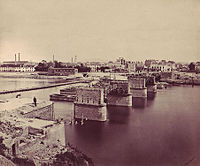
![Adolphe Braun: Gotthardbahn Luftlokomotive (výřez).[4]](http://upload.wikimedia.org/wikipedia/commons/thumb/0/07/CompressedAirLocomotive_Section1_AdolpheBraun1811to1877.jpg/200px-CompressedAirLocomotive_Section1_AdolpheBraun1811to1877.jpg)
![Adolphe Braun: Gotthardbahn Tunneleingang in Airolo (výřez).[4]](http://upload.wikimedia.org/wikipedia/commons/thumb/c/c5/CompressedAirLocomotiveNearTunnelEntranceInAirolo_Section1_AdolpheBraun1811to1877.jpg/190px-CompressedAirLocomotiveNearTunnelEntranceInAirolo_Section1_AdolpheBraun1811to1877.jpg)
![Adolphe Braun: Gotthardbahn Untere Tessinbrücke mit Giornico (výřez).[4]](http://upload.wikimedia.org/wikipedia/commons/thumb/d/d8/LowerTicinoBridgeWithGiornico_Section1_AdolpheBraun1811to1877.jpg/200px-LowerTicinoBridgeWithGiornico_Section1_AdolpheBraun1811to1877.jpg)
![Adolphe Braun: Gotthardbahn Strahllochbrücke (výřez).[4]](http://upload.wikimedia.org/wikipedia/commons/thumb/e/e3/StrahllochBridgeAndTunnelOfGotthardbahn_Section1_AdolpheBraun1811to1877.jpg/149px-StrahllochBridgeAndTunnelOfGotthardbahn_Section1_AdolpheBraun1811to1877.jpg)












